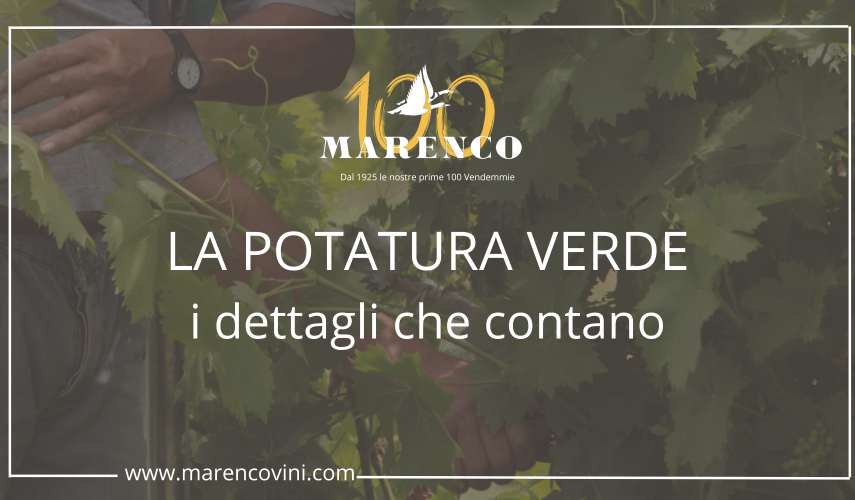Il lavoro nelle vigne non si ferma mai. Ancor meno in questo periodo, quello della potatura verde. La vite è una pianta e in quanto tale è un essere vivente che necessita di cure, attenzioni e passione.
In questo periodo sta entrando nel pieno dello sviluppo vegetativo, con gran vigore dell’apparato fogliare.
E’ in questo contesto che entra in gioco la potatura verde, una pratica agronomica essenziale, finalizzata al controllo della crescita della pianta al fine di migliorarne la salute e ottimizzare la produttività e la qualità del raccolto.
Si tratta di interventi mirati e delicati, principalmente manuali.
Si vanno ad eliminare germogli che crescono con troppo rigoglio e rapidità. In questo modo la pianta non sprecherà preziose risorse, che verranno invece impiegate per lo sviluppo dell’elemento più prezioso: il grappolo.
Con la medesima finalità di migliorare la distribuzione energetica vengono eliminati i germogli che nascono alla base della vite (polloni), i germogli doppi e, in fase successiva, i germogli secondari (femminelle).
Inoltre, la potatura verde permette la gestione dell’esposizione alla luce solare dei grappoli. L’irraggiamento diretto del grappolo è sempre stato di cruciale importanza per lo sviluppo e la qualità dell’uva.
Tuttavia, negli ultimi anni, con l’aumento delle temperature e l’allungarsi delle stagioni estive, l’eliminazione delle foglie verdi viene modulata in base all’andamento stagionale e alle variazioni di temperatura. Più le temperature salgono, più diventa cruciale preservare il patrimonio gusto-olfattivo intrinseco delle nostre uve.
Infine si procede alla cimatura, ossia il taglio del tratto terminale dei tralci. Questa pratica permette di evitare che essi crescano in maniera caotica, fuoriuscendo dalle strutture di sostegno. Nel complesso, insieme alle altre pratiche di potatura verde, contribuisce ad una migliore circolazione dell’aria, evitando ristagni di umidità che potrebbero favorire lo sviluppo di malattie fungine.
Con sapienza, pazienza e costanza Marenco media tra natura e scienza lungo un ciclo continuo, quello vegetativo e vitale della vite.
———————————————————————————————————————————————————————-
Work in the vineyards never stops. This is especially true during this period, the time of green pruning. The vine is a plant and, as such, a living being that requires care, attention and passion.
At this time, it is entering the peak of its vegetative development, with vigorous growth of the leaf system.
This is when green pruning plays a crucial role; it is an essential agronomic practice aimed at controlling the plant’s growth in order to improve its health and optimize the productivity and quality of the harvest.
These are targeted and delicate interventions, mostly manual.
The goal is to remove shoots that grow with too much vigor and speed. In this way, the plant will not waste valuable resources, which will instead be used to develop the most precious part: the grape.
With the same aim of improving the plant’s energy distribution, the shoots that grow at the base of the vine (suckers), the double shoots, and in a later phase the secondary shoots (side shoots) are eliminated.
Furthermore, green pruning allows a better management of sunlight exposure of the grapes. Direct sunlight on the grapes has always been crucial for the development and quality of the fruits.
However, in recent years, with rising temperatures and the lengthening of the summer seasons, the removal of green leaves is adjusted based on seasonal trends and temperature fluctuations. The higher the temperatures rise, the more crucial it becomes to preserve the intrinsic taste and olfactory qualities of our grapes.
Finally, topping is carried out, which is the cutting of the terminal part of the shoots. This practice helps prevent them from growing chaotically and extending beyond the support structures. Overall, along with the other green pruning practices, it contributes to better air circulation, preventing moisture stagnation that could favor the development of fungal diseases.
With wisdom, patience, and tenacity, Marenco mediates between nature and science along a continuous cycle, the vegetative and vital cycle of the vine.


